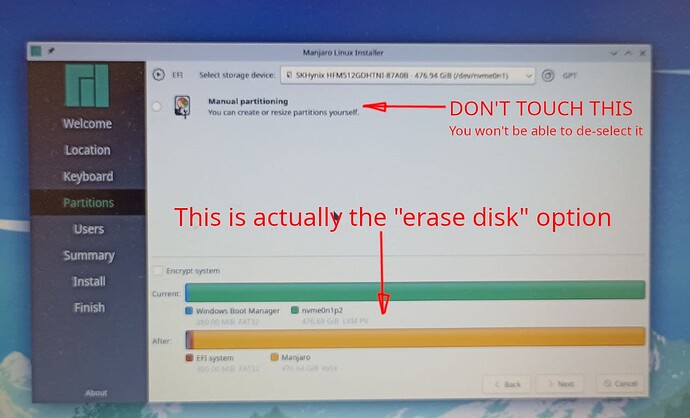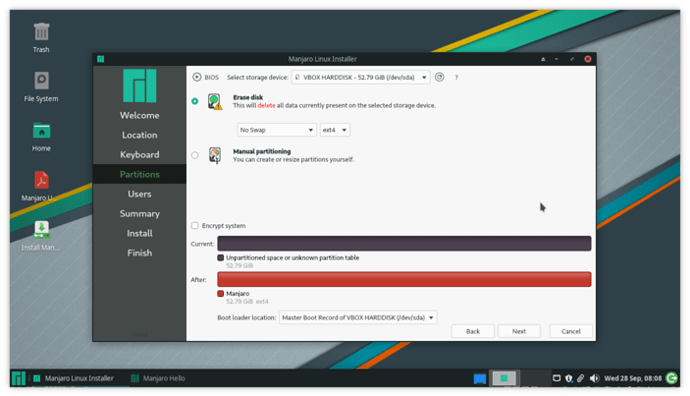Hi,
I have a laptop where I currently have OpenSUSE installed, whch is what I use daily, and I want to get rid of it and install Manjaro Linux instead.
So when I run the installer, it asks me what volume to install to, and that’s where I need to make sure that I don’t pick the wrong option. I don’t need to preserve anything existing, but I definitely don’t want to brick my computer.
The laptop originally came with Windows preinstalled (obviously), and it still shows up in the boot menu, although it doesn’t boot. Which I don’t care bacause I wouldn’t use it anyway.
These are the partitions that I see from Yast Disk Partitioner:
// PARTITIONS
- /dev/nvme0n1 476.94 GiB pci whatever
- nvme0n1p1 260.00 MiB EFI System Partition Partition /boot/efi
- nvme0n1p2 476.68 GiB PV of system <<<<<<<<<<<< wait WHAT?
- /dev/system 476.68 GiB LVM <<<<<<<<<<<< ???
- home 302.90 GiB XF5 LV /home
- root 166.45 GiB Btrfs LV /
- swap 7.33 GiB Swap LV swap
and these are the current entries in my boot menu:
// BOOT MENU
- openSUSE Tumbleweed
- Advanced options for openSUSE Tumbleweed
- Windows Boot Manager (on /dev/vnme0n1p1) <<<<<< this doesn't work (and that's expected)
- UEFI Firmware Settings
- Start bootloader from a read-only snapshot
So now I seem to understand that /dev/system is some sort of “virtual” volume that is actually physically within nvme0n1p2, right?
I think that originally used to contain Windows and its files, and I replaced it with OpenSUSE (including its bootloader, I guess), and that’s why the Windows boot entry won’t boot. I guess the reason I installed it this way, rather than wiping out everything, was either because the OpenSUSE installer gave me no other option, or because I was scared of ending up unable to boot.
When Manjaro’s installer asks me to choose the storage device, which one should I choose? These are the two options in the selector:
- /dev/system
- /dev/nvme0n1
I wish I could post screenshots ![]()
If I choose /dev/system, it then offers me a bunch of sub-options:
- install alongside
- replace a partition
- erase disk
and it seems in this case what I want is erase disk. Which in turn asks me to select a filesystem type and a type of swap, the default being “ext4” and “no swap”.
I would expect this to replace the three partitions that currently make up OpenSUSE with one whole partition that will contain Manjaro, which is what I want, but will this result in a bootable system?
I don’t care whether or not the new boot menu will still include the useless and non-working option for Windows - obviously it would be better to not have it, but it’s fine as long as I can boot Manjaro and don’t end up with an unbootable brick. Also I don’t care about the wasted 250 MiB.
I’m particularly worried because when it shows the future layout, it includes a small “EFI system” partition, and I wonder: won’t that conflict with the existing “EFI System” partition that is currently in nvme0n1p1 which is not going to be deleted?
So, considering the alternative: /dev/nvme0n1. This would kind of look cleaner in principle, because as I understand it, I’d be wiping out basically the entire hard disk, installing only Manjaro and keeping absolutely nothing else.
But if I choose that, there’s no “install alongside / … / erase disk” choice.
Instead, there is a single option:
- manual partitioning. You can create or resize partitions yourself.
and I’m not sure what that means.
In the future layout, it shows (like in the previous case) a small “EFI system” partition and a huge “Manjaro” one; but also a little bit of empty space at the beginning, for whatever reason.
So, with the former choice I am afraid that I may end up with two conflicting “EFI system” partitions, whatever they are; and with the latter choice I am afraid that I might wipe out whatever “boot record” (or whatever it’s called) currently exists, ending up in either case with an unbootable system.
Also I’m not sure what “manual partitioning” means, i.e. if I will have to manually define partitions in a later stage and won’t know what to do - or even worse, if it will be like “Go create the partitions by yourself in a terminal and come back when you’re done so the installation can continue”.
Any suggestion? I know all this would be easier with screenshots, but having just registered I am not allowed to upload images, and also I cannot upload them elsewhere and link them because I’m not allowed to post links either.

